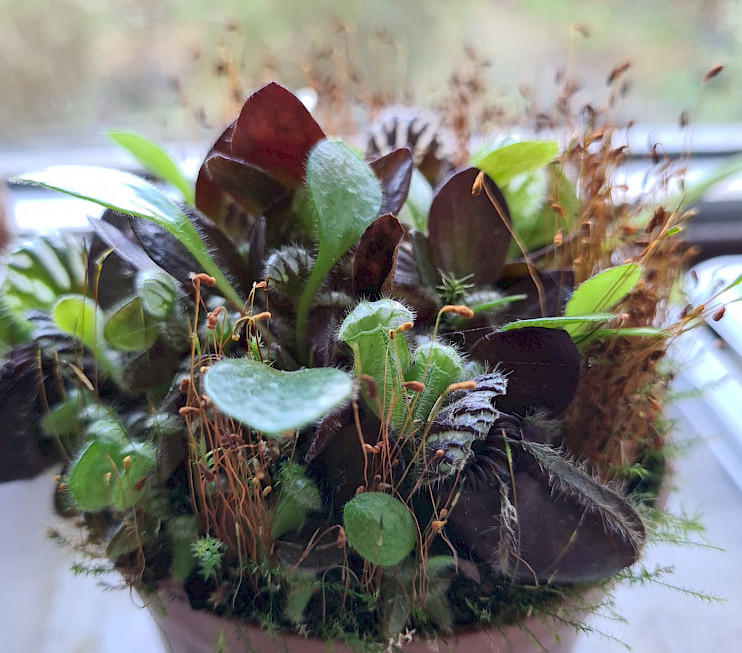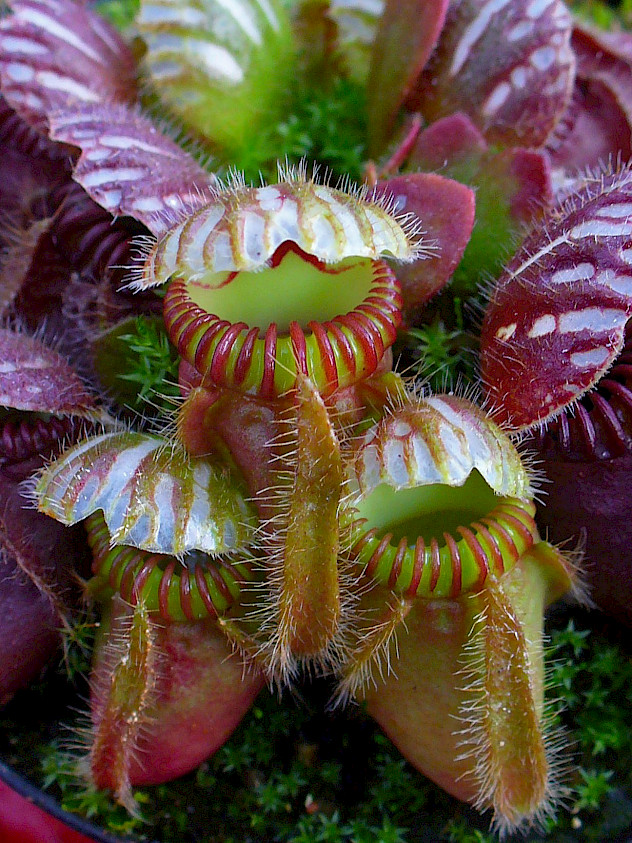

Cephalotus follicularis
General
Cephalotus follicularis, also known as the Albany pitcher plant, is a fascinating and enchanting carnivorous plant native to the southwestern corner of Australia. Highly prized by collectors and enthusiasts, it stands out for its intricate miniature pitchers and unique growth habits. Unlike many other carnivorous plants, it combines both terrestrial and pitfall trapping strategies, making it a true curiosity in the world of botany.
Physical Characteristics
This species features small, ground-hugging rosettes of leaves, which come in two forms: flat, non-carnivorous leaves and the distinctive, toothed, jug-like pitchers. Mature pitchers measure roughly 2–5 cm (up to 2 inches) tall and display vibrant green, yellow or reddish hues, often edged with translucent windows and adorned with bristly “teeth” along the rim. The constricted lid above the opener helps keep rain from diluting the digestive enzymes inside the trap.
Lifestyle
Using its pitchers, the plant attracts, drowns, and digests small insects such as ants and gnats. Nectar is secreted around the pitcher mouth to lure prey, which then slips and falls into the fluid below where it is broken down and absorbed. Flat, non-carnivorous leaves support photosynthesis through winter and during periods when prey is scarce.
Habitat and Protection
In the wild, this plant inhabits damp, lowland peat bogs and sand heathlands around Albany, Western Australia. It thrives in acidic, nutrient-poor soils with cool, humid conditions. Its natural populations are threatened by habitat loss and overcollection, so it is protected under Australian law and should only be acquired from reputable, legally certified nurseries.
Cultivation
Growing this plant at home can be both rewarding and challenging. It prefers bright, indirect light, cool temperatures, and, most importantly, consistent moisture with excellent root aeration. Due to its slow growth and sensitivity to changes, patience is essential for successful cultivation.
Special Features
Unique among carnivorous plants, it can survive long dry periods by retreating into its non-pitcher leaves. Its pitchers are among the most complex in structure and function for their small size, and its remarkable adaptability in coping with nutrient-poor environments makes it a living marvel of evolution.
Care
Light
Bright, filtered sunlight is ideal. Direct sun should be gentle, such as early morning light, to prevent burns, while deep shade leads to weak growth and green, floppy pitchers. If using artificial lights, maintain high intensity but avoid excessive heat.
Temperature
Cool conditions are crucial. Ideal daytime temperatures range between 18–25°C (65–77°F) with nighttime drops to 10–15°C (50–59°F). Extended high temperatures are stressful; avoid placing the plant in hot, stuffy locations.
Water
Use only soft, mineral-free water (rain, distilled, or reverse osmosis). Keep the soil uniformly damp, but not soggy—standing water should be avoided except on the hottest days. Watering from below helps to prevent pitcher rot.
Soil
A loose, well-draining, acidic mix is vital. A classic blend is 2 parts sphagnum moss to 1 part coarse sand or fine perlite. Avoid standard potting mixes and fertilizers, as they may harm the sensitive roots.
Nutrition
Do not use chemical fertilizers. The plant generally obtains enough nutrients from captured insects. If grown indoors, an occasional feeding of small insects is sufficient, but avoid overfeeding.
Humidity
While not as demanding as some tropical carnivores, moderately high humidity (50–70%) encourages healthy pitcher growth. Regular misting or the use of a humidity tray can be beneficial, especially in drier environments.
Dormancy
A cool, winter dormancy is natural and essential for long-term health. As days shorten and temperatures fall, growth will slow and many pitchers will die back. During dormancy, reduce watering but do not allow the plant to dry out completely. Resume regular care as new growth appears in spring.
Common Problems
Pitchers turn brown and shrivel prematurely
Cause: Soil is kept too wet or poor air circulation leads to rot.
Solution: Improve drainage, allow the soil surface to dry slightly between waterings, and ensure good airflow around the plant.
Pitchers fail to develop or remain pale and slender
Cause: Insufficient light or low humidity.
Solution: Increase light exposure (without overheating) and maintain higher humidity levels.
Stunted or deformed growth
Cause: Roots exposed to fertilizer or hard water buildup.
Solution: Repot in fresh, nutrient-free, acidic mix and use only purified or rainwater.
Sudden collapse of healthy-looking pitchers
Cause: Temperature shock, especially from moving the plant between very different environments.
Solution: Gradually acclimate the plant to new temperatures and avoid abrupt changes.
